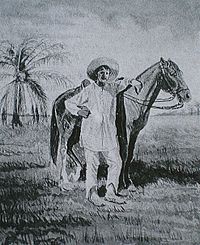Llanero

The Llaneros ( inhabitants of the plain ) are primarily the South American cattle herders of the Orinoco plain , which is located on Colombian and Venezuelan territory. The term is sometimes used for other cattle herders such as the Huasos in Chile , the Mexican Charros , the Qorilazos from Peru and for the Cowboys (also Vaqueros ) from the USA and accordingly for the Gauchos in Argentina and Uruguay .
With the establishment of the first Spanish colonial cities in the far north of South America ( Cumaná 1515, Santa Marta 1525, Coro 1527, Maracaibo 1529, Cartagena 1533, Bogotá 1538, El Tocuyo 1545, Pamplona 1549, Caracas 1567, Carora 1569), runaway grazing animals ended up in the open Savannah landscapes of the Llanos , which multiplied magnificently. Already 100 years later there are reports of huge herds of cattle and horses. This was the beginning of the Llanero culture, whose bearers were mainly composed of mestizos , Indians and former black slaves.
In the Venezuelan Wars of Independence (1810-1823) they played an important role in the militia of José Tomás Boves , which defended Spanish domination in the country. For the Llaneros, however, the main motive was that Boves also represented, at least verbally, a social revolutionary approach that turned against the privileged layers of the indigenous rulers (“The land of the whites for the colored!”) . On the other hand, Simón Bolívar's independence movement in 1813 was able to rely on a few hundred llaneros.
Individual evidence
- ↑ Michael Zeuske: Small history of Venezuelas. CH Beck, Munich 2007, ISBN 978-3-406-54772-0 . P. 19.
- ↑ Hans-Joachim König: National Liberation and Social Change. In: Imanuel Geiss and Rainer Tamchina (eds.): Views of a future historical science 2: Revolution - a historical longitudinal section. Munich 1974, p. 183.
- ↑ Orlando Araujo: Venezuela. Violence as a prerequisite for freedom. Frankfurt / M. 1971, p. 27. The question of the extent to which Boves actually pursued social revolutionary goals is debatable: cf. Hans-Joachim König: National Liberation and Social Change. , Munich 1974, p. 197.
- ↑ Manfred Kossok: The Iberian Revolution Cycle 1789-1830. In: Yearbook for the History of State, Economy and Society in Latin America 6. Cologne / Vienna 1969, p. 228.
- ^ Franz Kottenkamp: The independence struggle of the Spanish-American colonies. Stuttgart 1838, p. 103; Wolfram Dietrich: Simón Bolívar and the Latin American Wars of Independence. Hamburg 1934, p. 83.
Web links
- Web archive for the website of Cholo Valderrama ( Memento of March 12, 2012 in the Internet Archive ) (Spanish)
- Mi folclore llanero (Spanish)
